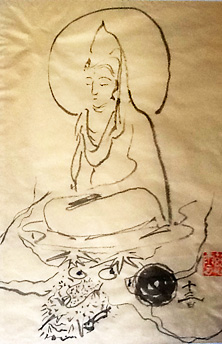|
DEFINING AWARENESS AND CONSCIOUSNESS
We do not live alone, but
chained to an animal
from another kingdom: our body.
Marcel Proust
Mankind is poised midway between
the gods and the beasts
Plotinus
At Meditation.dk, our
exploration of 'awareness' relies on these seemingly straightforward yet
profoundly nuanced notions: humans as instinctual beings, inextricably linked to
their bodies. By revisiting familiar landscapes with fresh perspectives, we
might uncover hidden dimensions previously ignored.
First and foremost, the quest for understanding awareness is an
inward journey—a probing examination of our internal bodily experience. This
realm is so immediate that we often take it for granted. We exist within the
dark inner world that lies behind our skin, scarcely acknowledging it. Despite
being largely overlooked, this inner bodily realm is far from alien.
Before we acknowledge,
understand and articulate our existence in words, we reside in a
peculiar inner realm of emotions and an almost infinite
variation of sensations. Here, our well known emotions are just
the tip of the iceberg. Beneath them lie even more profound
layers of life, ancient strata of abstract sensing that regulate
everything from our heartbeat's cadence to the sinuous movements
of our digestion. These sensations are hidden in plain sight.
They transpire in a sort of forgetfulness, akin to a humming
fridge: It was humming all along, but we only realize this in
the moment the humming stops.
The Two Forms of Consciousness
Before venturing further into this murky territory, it's
important to clarify a fundamental distinction. On
Meditation.dk, we differentiate between two modes of
'consciousness':
awareness and
consciousness.
Close your eyes, and you'll find that a multitude of sensory
signals emanate from your internal body-space, entering your
awareness. In this intimate, dimly lit world, you sense rather
than see.
This
experience is distinct from mere interoception;
you're not just attuned to internal sensations but also the
stimuli at the boundary of your body—your skin.
With
eyes closed, you still gain a 'sensed' understanding of your
surrounding environment. All these sensory inputs coalesce into
a subjective experience of spatial unity. The inner, sightless
eye perceives everything as a connected whole. (I will delve
deeper into this fascinating phenomenon in later chapters.)
One key takeaway is that this sensory awareness intensifies the
moment you close your eyes.
Upon reopening your eyes, the proximity of these sensations
fades. Engaging your eyes shifts your state—making you more
conscious, but paradoxically less aware of what is going on
inside of you. Here, consciousness intertwines with the act of
seeing, grounded in light; awareness is rooted in the process of
body-sensing, shrouded in darkness.
In this context, I define 'consciousness' as the brain's
most recently evolved, fully awake operating system—likely
accelerated by the advent of human language. It is not
equivalent with cognition but includes it as a space holder,
as a reflective mirror.
As images are seen in a mirror,
so the universe
is an image in the mirror of Consciousness.
Tripura Rahasya XL verses 53-54
This conceptual distinction aligns with Indian mystic
Nisargadatta Maharaj's views:
Awareness is primordial; it is the original state,
beginningless, endless, uncaused, unsupported, without parts,
without change. Consciousness is on contact, a reflection
against a surface, a state of duality.
There can be no consciousness without awareness, but there can
be awareness without consciousness, as in deep sleep. Awareness
is absolute, consciousness is relative to its content;
consciousness is always of something.
Nisargadatta
Maharaj - I AM THAT
Awareness is 'primordial'.
Awareness serves as the foundational layer of consciousness.
From an evolutionary perspective,
life developed awareness before waking consciousness. In this
sense awareness consists of the first steps towards develloping
the biological mirrors that on later stages were able to
concentrate the light of self-awareness into what we could call
consciousness.
To distill the
distinction:
● Awareness immerses in the immediate,
shadowy domain of sensation. It represents unity and immediacy;
a realm of dark 'suchness' devoid of traditional understanding.
Echoing this, Meister Eckhart notes, "God is pure presence,
residing solely within Himself."
● Consciousness embodies luminous cognitive alertness,
maintaining the duality and distance essential for
verbal understanding. As Meister Eckhart observes, "The closer we
align Him (God) with non-likeness, the better we understand Him."
In this way we could say that consciousness in fact is awareness
becoming aware of itself in a gap where awareness splits from
itself.


An infant develops
best in unlimited attentive close-sensing contact with the
mother. Sensing awareness develops before consciousness in a
person. An infant is undifferentiatedly attentive. Consciousness
only begins to develop along with language at the age of two or
three. The dog and child in the above illustration are not truly
consciously awake, but fully aware.
Dear reader, you may have observed
an intriguing paradox in the preceding passages. While I
characterize consciousness as a vessel for pure cognition, I
simultaneously draw from religious texts to illuminate this
concept. Consciousness, seen more as a reflective surface rather
than its contents, encompasses not only pure reason but also
narrative. Historically, this narrative hasn't always been
strictly rational. Among the most potent forms of narrative is
the religious kind, with its unparalleled ability to unify
people and galvanize them into collective action. Harari
astutely observes that humans are inherently storytellers, a
trait distinguishing us from all other creatures. This unique
capacity intriguingly combines the realms of empirical,
scientific reason with the often irrational realm of religious
narrative. As such, I aim to shed light on the enigmatic nature
of the consciousness 'mirror' by drawing upon both logical
reasoning and religious tales.
Now it's time to embrace 're-ligare', a Latin term meaning 'to
reconnect', urging us to return to our roots.
The Deep Roots of
Awareness
In Meditation.dk, the term 'awareness' embraces all
fundamental, latent, and semi-conscious states that predate our
more recently evolved, fully conscious state—a development that
may be as recent as 50,000 years ago. 'Awareness' is an
encompassing term referring to the processes related to our
earliest biological origins, reaching back to the times of
single-celled organisms in the Precambrian waters. (It is
imperative to have read the inaugural chapter, "Consiousnes
& evolution",
before delving further into this topic.) Given its extensive
evolutionary timeline, awareness is intricate, resembling a
patchwork tapestry.
While these ancient systems differ widely, they possess a shared
characteristic: They function autonomously, without the need for
linguistic understanding or expression. Within this domain, one
might feel as if floating amidst a nebula of nebulous sensory
stimuli. Each stimulus offers a distinct form of non-linguistic
communication ans instinct based action, wholly unique in its
nature. Nevertheless, a few of these systems have acquired
rudimentary verbal comprehension. This explains why a pep talk
in front of a morning mirror with affirmations like "I am
beautiful" or "I am a winner" can be invigorating. However,
these foundational aspects of our being can't converse using
words when reaching out to our conscious self. Their
communication is reminiscent of a perceptive dog: to some extend
understanding its owner's words but unable to verbalize a
response. Instead, they resort to their intrinsic modes of
communication, and the irony is that we often struggle more to
decode ourselves than understanding dog language.
To illustrate, consider the tension one might experience in the
ringed muscle around the anus, an area endowed with nerve
endings from our tailed predecessors. When the age-old monkey
inside feels threatened, it subconsciously tries to find balance
with a tail that has long since disappeared. Consequently, many
of us navigate modern landscapes unknowingly bearing the latent
tension of ancient primates. While Socrates' famed adage, "Know
thyself," might not have anticipated this particular nuance,
numerous individuals move through life with both tight asses and
stiff upper lips, often oblivious to these deep-rooted
sensations. (The playful mention of "tight asses" is, in this
context, a conscious nod to a Freudian slip)
The demarcation
between consciousness and awareness can be thus distilled:
consciousness interprets through dualistic, remote visual
perception, while awareness immerses in immediate, unified
sensing. However, it appears consciousness hasn't grasped the
reality that we've been existing for eons independently of its
interpretations.
This unconsciousness presents a curious paradox: By employing an
abundance of words in this chapter about awareness, it suggests
that everything herein is penned from the vantage point of
consciousness. Awareness cannot author its own tale, just as a
hundred monkeys typing away for a century wouldn't produce
any meaningful narrative on the subject.
The Unfathomable and Ancient Proximity of
Awareness
We are like trees. What is chronologically farthest from us is closest to
our core. The older a biological control system is, the closer it is to our
existence as a cellular living primordial ocean.
Precisely because of this age-related proximity,
'primitive' sensations and emotions are unconscious but aware. The older the
layers of attention activated, the closer they are, the less awake we are, and
the less do we understand them.
God is close to us, but we are far from Him.
God is within, but we are outside.
God is at home; we are strangers.
Meister Eckhart
The Aware but Unconscious
Body-Animal
We sense attentively. We feel our sensations. We experience
in awareness. We become aware of ourselves and the world through
sensations. Fundamentally, humans are sensing animals in their
attentive awareness. A dog is just as aware as a human.
Awareness-based survival responses rule in the twilight
landscapes, almost unknown to consciousness, between sleep and
waking. In the gray zones between sleep and waking, countless
archaic operating systems of awareness live, recycling ancient
genetic bio-software, making us the living landfill we are, seen
in loving misanthropy at our core.
Let us once again delve into Rumi's profound musings on the
soul's odyssey. Yet, this time, let's interpret his words with
the remembrance that all these evolutionary soul stages coexist
within us, here and now:
"Originally, you were clay.
From being mineral, you becamet vegetable.
From vegetable you became animal, and from animal, man.
During these periods man did not know where he was going,
but he was being taken on a long journey nonetheless.
And you have to go through a hundred different worlds yet.
I died from minerality and became vegetable;
And from vegetativeness I died and became animal.
I died from animality and became man.
Then why fear disapearance through death?
Next time I shall die Bringing forth wings and feathers like
Angels.
After soaring higher than angels-
You cannot imagine.
I shall be that."
Rumi
THE DUALITY OF SIGHT
Feeling and
sensing are intrinsic to our being. Yet, the vast corpus of
poetic writings worldwide captures only a sliver of the body's
inner sensory landscape. I dare to say that 90% of our lived
experience unfolds in the nuanced near-sensing of attentive
awareness, beyond the purview of consciousness's attempts to
understand. The intimate non-dual nature of awareness makes it
difficult for consciousness, with its penchant for distance, to
interpret the body's internal cues. Just as a painter steps back
to truly see and appreciate the entirety of their artwork, we
too must occasionally distance ourselves from the intricacies of
our lives to grasp the broader strokes of our being.
Close-range Sensing versus Long-range Perception
Close-range sensing, encompassing touch, taste, and smell,
is primarily governed by our older, more primal systems of
awareness. In contrast, our most recently evolved waking
consciousness is closely aligned with long-range or distant
perception, such as sight and hearing. The sense of sight is
intimately tied to our state of consciousness, offering us a
sharp perception of our surroundings. In Danish, being fully
awake is termed 'lysvågen,' which aptly translates to
'light-awake'.
In the attempt to
shed light on the letters it is not a good idea to read a book
with our nose pressed to the pages.
Consciousness
is always trying to place some distance between itself as the
observer and the observed. Otherwise we cannot find ourselves
and we come to resemble
Jethro Tull's hare that lost its spectacles, unable to
realize they were perfectly positioned all along.
Cognitive
Validation of Emotions through Visual Distance
Sight is frequently heralded as humanity's paramount
conscious sense, offering a means to validate our internal
world. Our propensity to privilege visual cues over sensations
from other senses suggests an intricate interplay between
consciousness and awareness. This interdependence manifests when
we seek visual representation of emotions, almost suggesting, "To
understand my emotions, I must see them." In order to get
insight, to shed light on a subject, distance is required. This
visual distance sets the stage for the duality between the
observer and the observed.
In this sense the price we pay for understanding ourselves is
that we get alienated towards ourselves. We can only look at and
understand ourselves by not being ourselves. That is why we
close our eyes in meditation. Meditation is the art of temporary
blinding ourselves in order to find what understanding cannot
see.
Hence, in order to gain spiritual wisdom (as opposed to
understanding) the norse god Odin, according to mythology, had
to sacrifice one eye.
In the same line of thinking Meister Eckhart claims:
Had I a God whom I could understand, I would no longer hold him
for God.
We loose our
inexplainable nature by explaining it.
The more we can impute to Him
(God) not-likeness,
the nearer do we get to understanding Him.
Meister Eckhart
The phenomenon of leaning heavily
on visual cues to process or validate our experiences is,
however, deeply ingrained in human behavior. Here are some more
examples:
Several facets of
human behavior reflect our deep-rooted reliance on visual
perception: "Seeing is Believing" – This proverbial wisdom
underscores that, for many, visual evidence outweighs oral
testimonials. A picture, they say, is worth a thousand words. In
this digital age, that might extend to videos being even more
potent than photographs in affirming truths.
Interestingly, thought formation shares a closer affinity with
audition; we often 'hear' our internal monologues. Before
written words, pivotal cultural narratives passed through
generations via oral traditions. Hearing, thus, operates as an
ambiverted sense—equally adept at close and long-range
perception. This versatility of sound elucidates why powerful
oratories or captivating melodies can penetrate our conscious
guard and resonate with the intuitive, more primal facets of our
being. Both spiritual leaders and persuasive orators harness
this capability, reaching the profound archetypal layers of
humanity through auditory means. However, the persuasive power
of voice and sound to seems only to function when there a
regression of consciousness is happening. This peculiar
phenomenon can be observed at is fullest in any speech made by
Hitler.
Humans: A Battlefield for Evolutionary Conflicts
As explind in the chapter,
Consiousnes & Evolution,
humans are a melting pot of cells and bacteria, hosting diverse
bio-operating systems ranging from the Precambrian era to now.
At the convergence of these systems, few communicate through
language. Some resonate with emotions, while the most ancient
ones respond solely to sensory input. These inherent temporal
disparities breed internal conflicts: our primal instincts clash
with the newly awakened human faculties.

The above Chinese watercolor
depicts a meditating Zen monk, peacefully seated atop a creature
that is primitive yet vaguely humanoid. This portrayal is in
line with a longstanding tradition featuring Buddhas,
Bodhisattvas, and meditating monks. To symbolize consciousness's
triumphant victory over animalistic instincts, they are often
illustrated riding dragons, lions, or tigers. What's perhaps
unintentionally amusing about this particular watercolor is the
slightly disgruntled and sidelong glance the creature seems to
cast, at least to my eyes.
If I were the monk, I'd be wary of resting too confidently on
this formidable perch. It feels as if the creature is simply
waiting for an opportunity to topple the monk from his pedestal.
Our newfound, almost microscopic consciousness, is inherently
fragile at its core. The light of consciousness shines like a tiny
flame at the end of a matchstick, easily extinguished.
With warm regards,
Gunnar Mühlmann
gunnars@mail.com
|





